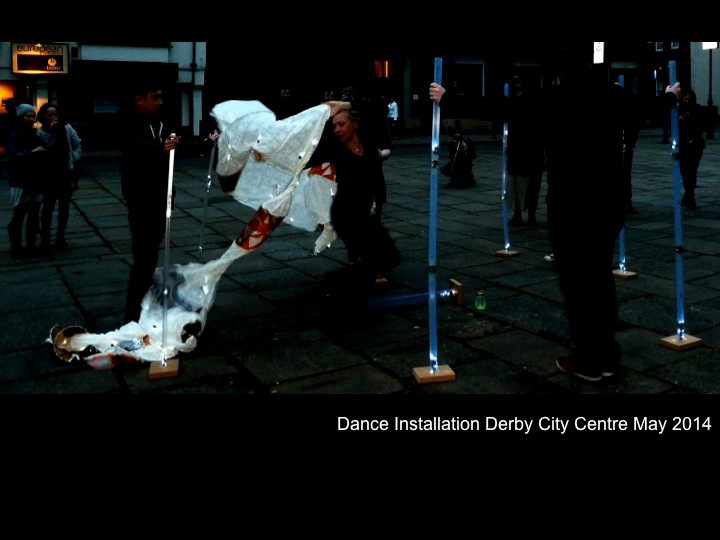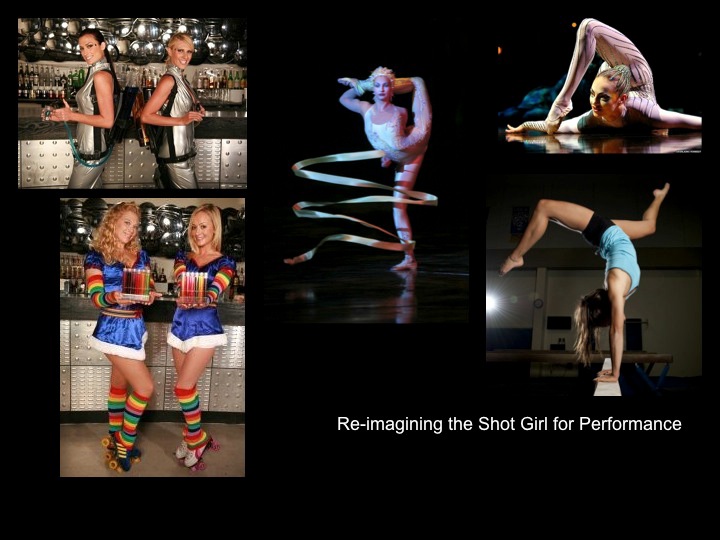I recently entered the Heineken iconic bar design challenge, I was one of the chosen finalists who were asked to go down to their pop up bar in London and give a presentation on what we thought we could develop wiithin the brief of a point of sale that promoted social design. The presentation was in the Pecha Kucha format meaning I had to produce a 20 slide presentation where each slide was on screen for only 20 seconds before automatically moving on. The below movie shows my presentation and the following text what I said on each slide. I hope to hear from Heinken in the future as to whether I was chosen to procede with the project.

Slide 1
Over the past year I have been looking at how performance can be used as a part of architecture and installation to promote interaction and engagement. I created an installation that was installed by the actions of a dancer. This started me thinking about what elements of a night out are already inherently a performance – getting ready, dancing, ordering a drink and of course shot girls…

Slide 2
I wondered if there was a way to re-imagine shot girls to create a performance that was fun, new and served Heineken. Maybe they would be a contortionist unraveling to reveal your drink or a gymnast flipping across the space to deliver it.

Slide 3
Then I thought why not remove the girl entirely and have your drink delivered in a similar way to the breakfast machine in Chitty Chitty Bang Bang. After researching Rube Goldberg Machines, like this one and the more recent example of Ok Go’s music video for This To Shall Pass, I realised I had over complicated the thought process. At it’s core I was talking about was interaction.

Slide 4
I went back to one of my favourite design studio; Studio Roosegaarde and their term Intuitive Interaction. All of their projects embrace an element of interaction that is so apparent that passers buy cannot help but interact with it. This is what my project needed to promote the element of design I always try to achieve – engagement.

Slide 5
In the end the perfect starting point for me was the Heineken slogan, Open Your World. The idea I want to present to you today is of a piece of bar furniture that opens up, through interaction, to reveal it’s treasure – Heineken

Slide 6
I explored my ideas within two categories; Remote Interaction and Direct Interaction. In this way I could explore ideas that people could interact with passively alongside ideas where a more active participation with the designed object is needed.

Slide 7
After working out the ideas with more specific elements I narrowed into People Interacting with Each Other as the key idea for Remote Interaction. Using social interaction as a medium for the interactivity best promotes the positive environment that can be achieved with community engagement.

Slide 8
I also expanded upon my original points within direct interaction; here I found that combining the majority of the ideas would be the best option. This way I could create a truly interactive piece of furniture that responds in multiple ways to the touch and interest of customers. I will now expand briefly on these two key ideas.

Slide 9
When thinking about using human interaction as a trigger for my design it reminded me of this project. The project created a unique photo booth where the meeting of skin, or in most cases a kiss, activated the shutter. This is a great example of how interaction can be promoted through the creation of something.

Slide 10
The two mechanisms I thought would work well in a bar situation were a wearable item that could be handed out upon entry or a word/phrase recognition system. The wearables could measure for social movements such as shaking hands. While the phrase recognition system could track people interacting positively. As the data accumulates the more the furniture opens.

Slide 11
When thinking about the combination of ideas for the direct interaction I looked at projects that used a folding mechanism, reactive panels or other elements that reacted to touch such as the bar top in a previous Heineken project. All these projects use the intuitive nature of humans to touch things and see what happens.

Slide 12
A folding motion really appealed to me and I looked at other examples of where unfolding was used as a design tool. The way this motion can transform the shape, permeability and atmosphere of an object intrigued me. The thought that interaction with this structure could make it more dynamic was a strong one for me.

Slide 13
Based on these ideas I did some quick sketches on how I thought the structure could be formed. The underlying elements would be a formation of geometric shelving units which I will elaborate on later. This foundation would play host to the interactive façade that through the touching and moving of the panels would open up to reveal the Heineken shelved within.

Slide 14
Here are some mock ups of the kind of shapes the façade could be formed of. It would be created in sections so that as the panels are manipulated they open up in different ways to create different views within.

Slide 15
Next I wanted to consider the treasure that was to be discovered, how would the Heineken be revealed and how could I showcase the bottles of beer. It was then that I came across these images and it started me thinking of how different formations of the bottles could create interesting patterns. It also highlighted to me the beauty of the glass itself especially when lit.

Slide 16
To make the most of this I am suggesting a series of geometric shelving units that would hold rows or stacks of bottles in different formations and orientations within the structure. Using this system, as the panels are peeled back different aspects of the bottle will be revealed and different patterns will emerge. This system also allows for the structure to be formed at multiple scales.

Slide 17
As I mentioned before I think the glass of the Heineken bottle responds really well to light so I wanted to look at how light could be used within the structure not only to highlight the bottles but also the faceted facade. These two examples show well how light can be used to enhance folded features both with colour and without.

Slide 18
I know form past experience how interactive lighting can be especially in a night time environment. This project of mine was 100 magnetic LEDs attached to existing street furniture in Derby. People were intrigued by them; moving them around and making their own formations of light. If the panels of the structure were lit possibly with a form of reactive light I feel people would respond in a similar way.

Slide 19
I think the best way to achieve this would be to use OLED lights as they create surface light and have been previously used in an interactive way. Making the panels up with this technology in red white and green, while programming them to shine brighter when touched, could create a visually stunning element.

Slide 20
I’ve spoken to you about a few ideas here today, most of which could be combined in some way or developed individually at different scales I hope you enjoyed it, thank you for listening and I welcome any feedback anyone has.


